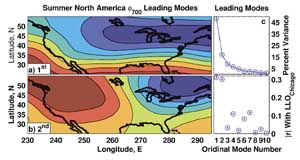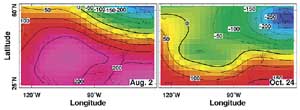New University statistical center will assess environmental impact on health
By Steve KoppesNews Office
 Statistical data, such as those shown above––which look at the relationship between low-level ozone and meteorological processes that may impact asthma incidence in Illinois––will help scientists in the new statistical center determine how such environmental factors affect human and ecological health. |
A new environmental statistics center being created at the University will tackle projects ranging from the relationship between air quality and asthma incidence in Illinois, to the impact of airborne particulates on infant health.
Over the next five years, the Environmental Protection Agency will provide more than $6 million to support the University’s new Center for Integrating Statistical and Environmental Science.
“Our main objective is to advance the use of statistics to provide the best assessments of the state of the physical environment and its impact on human and ecological health,” said center Director Michael Stein, Professor in Statistics and the College. “Given the need for the EPA to develop reliable standards to regulate air and water pollution and the wide-ranging impact that such regulations will have on industries and public health, we maintain that afford-ing scientists and statisticians the opportunity to interact and combine their abilities is essential to providing a sound scientific basis for developing cost-effective approaches to assess, manage and reduce environmental risk.”
Affiliated with the center are 23 scientists from the University; Argonne National Laboratory; National Oceanic and Atmospheric Administration; University of Colorado; University of Wisconsin; University of California, Berkeley; University of Illinois, Urbana-Champaign; and the University of Michigan. These scientists hale from a variety of disciplines, including statistics, geophysics, economics, ecology and medicine. “This is not necessarily a group of people who sit in the same room too often,” Stein said.
 |
The center’s five initial projects are as follows:
Air quality and reported asthma incidence in Illinois.
“Asthma, at least reported asthma, has been going up quite dramatically in pretty much all of the developed world in recent decades,” Stein said. In this study, scientists will attempt to determine to what extent air pollution causes increased episodes of acute asthma in Illinois and especially in Chicago. John Frederick, Professor in Geophysical Sciences and the College, will lead this study.
The detection of ozone recovery.
The Earth’s stratospheric ozone layer has been on the decline since the mid-1980s. With the successful implementation of international legislation to control ozone-depleting substances, scientists now predict a recovery. This project aims to assess how soon monitoring efforts will be able to detect the recovery. The results of such a study would be useful in showing that efforts to control ozone-depleting substances in the United States and elsewhere have been effective. George Tiao, the W. Allen Wallis Professor in Econometrics and Statistics in the Graduate School of Business, will head up this study.
Impacts of airborne particulates on infant health.
An important, yet unresolved, issue for public policy is the extent of a casual relationship between human health and air pollution. In order to inform this issue, center scientists will exploit differential changes in particulates concentrations across U.S. counties due to variation in the stringency of environmental regulation. The aim is to test whether the counties with larger regulation-induced reductions in particulates also experienced larger reductions in infant mortality. Michael Greenstone, Assistant Professor in Economics and the College, will serve as co-leader of this study.
Integrating numerical models and monitoring data.
Physically based numerical models and actual pollution measurements are the two main sources of information for studying air and water pollution. Scientists at the new center will develop methods to combine these two sources. The results could help researchers produce more accurate pollution forecasts and ozone alerts. “Short-term prediction of pollution levels is required to determine when to issue pollution alerts or when to require temporary cuts in emissions to avoid high pollution levels,” said Stein, who will lead this study.
Modeling ecological complexity.
Scientists use mathematical models to better understand ecological phenomena that range from the dynamics of the population of a single species to that of an entire ecosystem. Yet the complex interactions between species in time and space make it difficult to select the best statistical analysis to address a given issue. Center scientists will work toward a solution. The work has wide-ranging implications for conservation, pest management, harvesting and land use. Greg Dwyer, Assistant Professor in Ecology & Evolution, will lead this study.
![[Chronicle]](/images/small-header.gif)